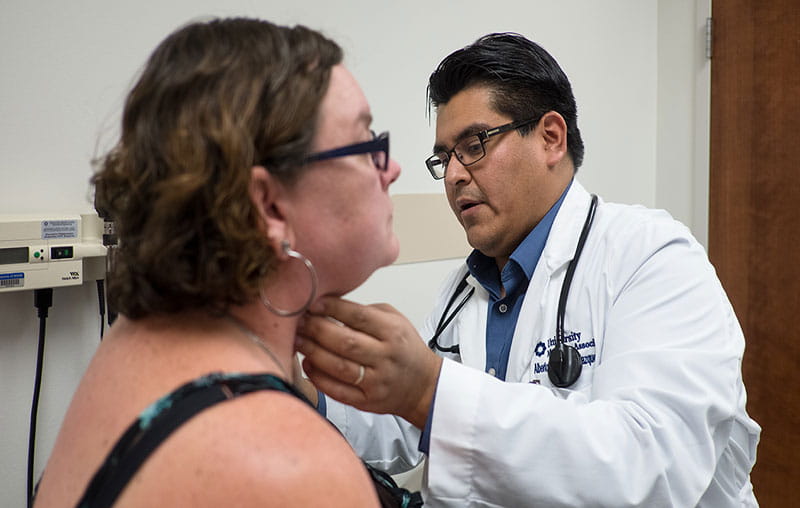If you’ve been diagnosed with diabetes, it means your blood sugar is higher than it should be. Excess sugar in the blood can damage blood vessels throughout the body, including those in the eyes. This can result in diabetic retinopathy.
Dr. Alberto Chavez Velazquez is an endocrinologist at University Health’s Texas Diabetes Institute. “Retinopathy is one of the major microvascular complications (of diabetes) and fortunately can be prevented,” Dr. Velazquez said.
People with prediabetes should also be aware of their risk for retinopathy. “Between 8-10% of people with prediabetes already show signs of retinopathy,” Dr. Velazquez said.
What Is Diabetic Retinopathy?
Diabetic retinopathy damages the tiny blood vessels in the retina, causing them to swell and leak fluid. In some cases, existing blood vessels may close off and new abnormal blood vessels may grow on the retina. Untreated diabetic retinopathy may lead to vision loss and even blindness.
Diabetic retinopathy is more common in people with uncontrolled diabetes and those who are unaware they have diabetes.
Who Is at High-Risk for Diabetes-Related Retinopathy?
Anyone with diabetes is at risk of developing diabetic retinopathy. It’s the leading cause of vision loss in people with diabetes. In fact, according to the National Institute of Diabetes and Digestive and Kidney Diseases, 1 in 3 people aged 40 or older who have diabetes show early signs of diabetic retinopathy.
That doesn’t mean, however, that you will automatically develop the disease if you have diabetes. The risk of developing the condition increases with age. It’s more common among those with certain risk factors, including:
- Smoking
- High blood sugar
- High blood pressure
- High cholesterol
Certain groups have an increased risk of developing diabetic eye disease, including diabetic retinopathy. They are:
- African Americans
- American Indians
- Alaska Natives
- Hispanics
- Pacific Islanders
Women with diabetes who become pregnant or those who develop gestational diabetes are also at an increased risk.
Signs and Symptoms of Diabetic Retinopathy
What does diabetic retinopathy look like? In many cases, diabetic retinopathy doesn’t cause noticeable symptoms in its earliest stages. This is why having regular screenings are crucial. Treating it early can help slow the progress of the disease.
As the condition progresses, it may cause:
Blurred vision
What you’re seeing may be blurred or appear wavy in some cases.
Poor night vision
You may have difficulty seeing in low light conditions, including at night. It may also be more difficult to see in changing light conditions, such as moving from a well-lit room to a darker one.
Eye floaters
It is common to see spots or dark “strings” that seem to be in your eyes or in front of them. You may also see flashes of light at times.
Impaired color vision
You may have difficulty deciphering between colors.
Poor peripheral vision
It may become more difficult to see to the side, what is known as your peripheral vision.
Nearsightedness or farsightedness
You may experience changes in vision, including your ability to see up close or at a distance. It is also not uncommon to have your vision fluctuate from day to day.
Diabetic Retinopathy Screening
Dr. Velazquez says people with prediabetes and Type 2 diabetes should get their vision screened regularly. “Patients with Type 2 diabetes should be screened at diagnosis and then every year,” he said.
University Health providers at Texas Diabetes Institute use Intelligent Retinal Imaging Systems (IRIS), a retina imaging device, to detect changes in eye health. This helps them identify a high volume of patients with signs of diabetic retinopathy in Bexar County.
Once your provider identifies signs of diabetic retinopathy, they will determine next steps. Treatment options will depend on how advanced the condition is.
Can Diabetic Retinopathy Be Reversed?
Prevention and early intervention are key to preserving your eyesight. In most cases, the damage caused by diabetic retinopathy is not reversible. It is crucial to identify signs of diabetic retinopathy as soon as possible to slow the disease’s progression.
Medication
While most treatment options focus on stopping the damage to your eyes, some newer treatment options—known as anti-VEGF drugs—have been shown to slow and even reverse diabetic retinopathy. These medications are injected into the eye and work by blocking VEGF, or vascular endothelial growth factor.
Too much of the VEGF protein causes blood vessels in the retina to swell and leak, so blocking it can slow damage. In some cases, these injected medications have even been shown to recover some vision loss.
Lifestyle Changes & Diabetes Management
Making lifestyle changes to lower your blood sugar and mitigate other risk factors, including exercising regularly and eating a healthy diet, can also help slow the disease. Find diabetes education classes at Texas Diabetes Institute.
When to Seek Care for Diabetic Retinopathy
Because early-stage diabetic retinopathy may not cause any symptoms, the National Eye Institute recommends that those who have diabetes undergo a dilated eye exam with an eye health professional each year. These exams allow a provider to get a detailed look at the anatomy of the eye, surveying it for damage.
It is important to treat diabetic retinopathy as early as possible because it will continue to damage the eye. Untreated diabetic retinopathy can also lead to other eye conditions, including diabetic macular edema, neovascular glaucoma and, in some cases, retinal detachment.
Getting routine eye exams and seeking care promptly for emerging symptoms can help prevent that.
Diabetic Eye Care at Texas Diabetes Institute
University Health Texas Diabetes Institute provides specialized eye care for people with diabetes.






